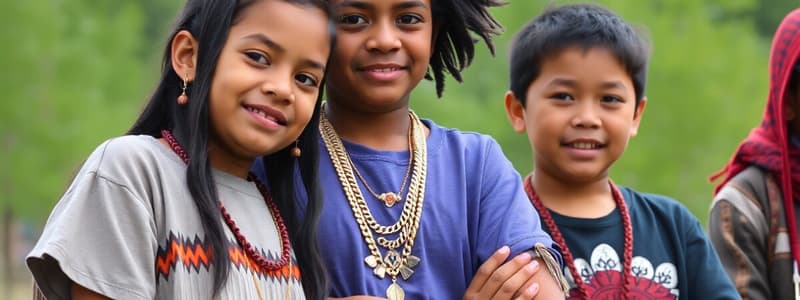Podcast
Questions and Answers
According to the speaker, what was the original intent behind the treaties signed with First Nations people?
According to the speaker, what was the original intent behind the treaties signed with First Nations people?
- To force assimilation of First Nations people into the dominant culture.
- To share the land with First Nations people based on mutual respect. (correct)
- To create a system of resource exploitation benefiting only the government.
- To establish complete governmental control over First Nations territories.
What preliminary step does the speaker suggest is necessary before achieving a mutually respectful relationship?
What preliminary step does the speaker suggest is necessary before achieving a mutually respectful relationship?
- Holding more conferences and discussions about reconciliation.
- Ensuring young people understand and value their own identity and heritage. (correct)
- Establishing new legal frameworks for resource management.
- Increasing funding for government programs in Indigenous communities.
What societal issue does the speaker highlight as a consequence of young people lacking a sense of identity and responsibility?
What societal issue does the speaker highlight as a consequence of young people lacking a sense of identity and responsibility?
- Decreasing rates of cultural preservation.
- High rates of suicide, self-abuse, addiction, and incarceration. (correct)
- Increased political activism among Indigenous youth.
- Greater participation in mainstream sports and recreation activities.
According to the speaker, what was a key finding of the Aboriginal Justice Inquiry in Manitoba in 1991?
According to the speaker, what was a key finding of the Aboriginal Justice Inquiry in Manitoba in 1991?
How has the nature of crime committed by Aboriginal people changed since the 1991 report, according to the speaker?
How has the nature of crime committed by Aboriginal people changed since the 1991 report, according to the speaker?
What does the speaker identify as a driving force behind the shift in the nature of crime within Aboriginal communities?
What does the speaker identify as a driving force behind the shift in the nature of crime within Aboriginal communities?
What does the speaker see as the ultimate solution to the problems facing Aboriginal communities?
What does the speaker see as the ultimate solution to the problems facing Aboriginal communities?
How does the speaker believe the education system contributed to the current state of affairs?
How does the speaker believe the education system contributed to the current state of affairs?
What specific change does the speaker advocate for in the education system?
What specific change does the speaker advocate for in the education system?
What is the unintentional consequence of teaching Aboriginal children that their culture is inferior, according to the speaker?
What is the unintentional consequence of teaching Aboriginal children that their culture is inferior, according to the speaker?
What unconscious statement made by the Prime Minister does the speaker critique?
What unconscious statement made by the Prime Minister does the speaker critique?
What overall goal should underpin all actions taken towards reconciliation, according to the speaker?
What overall goal should underpin all actions taken towards reconciliation, according to the speaker?
What does the speaker suggest is necessary to keep the goal of mutual respect at the forefront of thinking?
What does the speaker suggest is necessary to keep the goal of mutual respect at the forefront of thinking?
What is the speaker implying by saying, "Stop acting like you own the place and understand that we own it, too. But now we own it together"?
What is the speaker implying by saying, "Stop acting like you own the place and understand that we own it, too. But now we own it together"?
How does the speaker define reconciliation?
How does the speaker define reconciliation?
According to the speaker, what happens if young people lack a sense of validity in their lives?
According to the speaker, what happens if young people lack a sense of validity in their lives?
What is the speaker advising when referring to Aboriginal heroes such as Tecumseh, Big Bear, and Pound Maker?
What is the speaker advising when referring to Aboriginal heroes such as Tecumseh, Big Bear, and Pound Maker?
The speaker uses the word "Indian" advisedly. What does this imply in the context of the speech?
The speaker uses the word "Indian" advisedly. What does this imply in the context of the speech?
What is the speaker’s main intention for bringing up the prime minister’s comment about Canada having no history of colonialism?
What is the speaker’s main intention for bringing up the prime minister’s comment about Canada having no history of colonialism?
What central message is the speaker trying to convey about reconciliation?
What central message is the speaker trying to convey about reconciliation?
Flashcards
What is Reconciliation?
What is Reconciliation?
Reconciliation is about establishing the respectful relationship that was originally intended.
Preliminary Step to Reconciliation
Preliminary Step to Reconciliation
Before mutual respect, Indigenous children need self-respect, knowledge of their identity, Creation story, and responsibilities.
Consequences of Lost Identity
Consequences of Lost Identity
High rates of suicide, abuse, addiction and incarceration reflect a loss of identity and purpose among Indigenous youth.
Education as a Solution
Education as a Solution
Signup and view all the flashcards
Importance of Indigenous Heroes
Importance of Indigenous Heroes
Signup and view all the flashcards
Education's Dual Impact
Education's Dual Impact
Signup and view all the flashcards
Source of Unconscious Racism
Source of Unconscious Racism
Signup and view all the flashcards
Ultimate Goal of Reconciliation
Ultimate Goal of Reconciliation
Signup and view all the flashcards
Study Notes
- Reconciliation centers on the idea of respect.
- First Nations people intended treaties to mean sharing land, mutual coexistence, and reciprocal respect.
- An Elder defined reconciliation as the government acknowledging shared ownership of the land.
- Reconciliation aims to establish the respectful relationship initially intended with the treaties.
Instilling Self-Respect in Indigenous Youth
- A preliminary step to reconciliation involves fostering self-respect in Indigenous children.
- Many Indigenous youths lack knowledge of their heritage, Creation stories, and identities.
- Providing them with a sense of validity and identity is crucial.
- Understanding their responsibilities to the Creation is also essential.
- Failure to do so perpetuates self-destructive behaviors evident in high suicide, self-abuse, addiction, and incarceration rates.
- In 1991, the Aboriginal Justice Inquiry in Manitoba reported 77% of incarcerated youths were Aboriginal; this figure is likely nearly 90% now.
- The solution involves strengthening the Indigenous youth's sense of identity and mutual responsibility, rather than just addressing issues within the justice system.
- Crime among Aboriginal people has shifted inward, with increased violence directed towards other Aboriginal youths due to negative influences like gangs.
The Role of Education
- Flawed education, particularly the residential school system, contributed to the current situation.
- Education is key to rectifying the issues.
- The education system needs reform for both Aboriginal and non-Aboriginal children.
- Education should include knowledge about the legacy of residential schools.
- It should teach the validity of Aboriginal peoples, their belief systems, origins, and cultural figures.
- Showcasing Aboriginal heroes like Tecumseh, Big Bear, and Pound Maker is vital.
- The current education system has inadvertently taught both Aboriginal and non-Aboriginal children that being Aboriginal is inferior.
- This has given non-Aboriginal children a false sense of superiority, leading to racism.
- Racism manifests in words, actions, thoughts, and unconscious behaviors.
Moving Forward with Reconciliation
- A prime minister's heartfelt apology for past wrongdoings was undermined by a later statement denying Canada's history of colonialism.
- Educational reform should aim to give young people a sense of validity, purpose, and identity.
- The objectives of reconciliation will not be achieved in five years.
- All actions moving forward should be based on the goal of mutual respect.
Studying That Suits You
Use AI to generate personalized quizzes and flashcards to suit your learning preferences.
Description
The path to reconciliation begins with instilling self-respect in Indigenous youth. Many lack knowledge of their heritage and identities, leading to self-destructive behaviors. Providing them with a sense of validity, identity, and understanding their responsibilities to the Creation is crucial.





